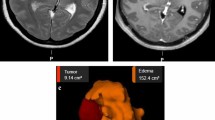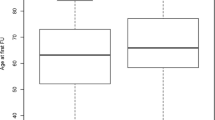Summary
Peritumoural brain oedema was examined retrospectively in 175 patients with 179 intracranial meningiomas. The influence of tumour size, location and histology were investigated.
Tumour volume and localization, and the presence of peritumoural brain oedema (PTBOe) were determined by computed tomography (CT). The oedema-tumour volume ratio was defined as Oedema Index (Oel). All patients underwent microsurgical removal of the tumour. Surgically resected meningiomas were classified histopathologically based on criteria of the new World Health Organization (WHO) classification. A close relationship was found between the tumour size and the incidence of peritumoural oedema: with increasing size of the tumour the incidence of oedema also rises, the oedema index, however decreases. Frontobasal and temporobasal meningiomas showed a significant increase in the oedema incidence and the mean oedema index. If major parts of the surface of meningiomas were adjacent to subarachnoid cisterns only a slight tendency for the development of oedema was observed. WHO-III-meningiomas showed a significantly higher oedema incidence (61.1% vs. 94.4%; p<0.004) and mean oedema index (Oel=2.7 vs. 3.7; p<0.0009) than WHO-I-meningiomas. Brain tissue was affected in 59 cases. 19 meningiomas with infiltration into adjacent brain parenchyma revealed a statistically significant increase in oedema incidence (94.7% vs. 51.7%; p<0.0003) and mean oedema index (Oel=3.9 vs. Oel=2.2; p<0.0001) when compared to tumours without any brain tissue involvement in the histopathological specimens. Tumours with large volume, fronto-temporo-basal location and anaplastic histology were not only associated with the highest incidence of oedema formation but also presented with an overproportionate infiltrative growth. Thus, a disruption of the arachnoid or a true brain infiltration may be an essential factor for the development of a PTBOe.
Similar content being viewed by others
References
Alvarez F, Roda JM, Romero MP, Morales C, Sarmiento MA, Blázquez MG (1987) Malignant and atypical meningiomas: a reappraisal of clinical, histological, and computed tomographic features. Neurosurgery 20: 688–694
Benzel EC, Gelder FB (1988) Correlation between sex hormone binding and peritumoural oedema in intracranial meningiomas. Neurosurgery 23: 169–174
Bitzer M, Wöckel L, Luft AR, Wakhloo AK, Petersen D, Opitz H, Sievert T, Ernemann U, Voigt K (1997) The importance of pial blood supply to the development of peritumoural brain oedema in meningiomas. Neurosurg Focus 2: Article 4
Bradec GB, Ferszt R, Bender A, Schörner W (1986) Peritumoural oedema in meningiomas. A radiological and histological study. Neuroradiology 28: 304–312
Constantini S, Tamir J, Gomori MJ, Shohami E (1993) Tumour prostaglandin levels correlate with oedema around supratentorial meningiomas. Neurosurgery 33: 204–211
De Vries J, Wakhloo AK (1993) Cerebral oedema associated with WHO-I, WHO-II, and WHO-III-Meningiomas: correlation of clinical, computed tomographic, operative and histological findings. Acta Neurochir (Wien) 125: 34–40
Gilbert JJ, Paulseth JE, Coates RK, Malott D (1983) Cerebral oedema associated with meningiomas. Neurosurgery 12: 599–605
Go KG, Kamman RL, Wilmink JT, Mooyart EE (1993) A study on peritumoural brain oedema around meningiomas by CT and MRI scanning. Acta Neurochir (Wien) 125: 41–46
Go KG, Wilmink JT, Molenaar WM (1988) Peritumoural oedema associated with meningiomas. Neurosurgery 23: 175–179
Hiyama H, Kubo O, Tajika Y, Tohyama T, Takakura K (1994) Meningiomas associated with peritumoural venous stasis: three types on cerebral angiogram. Acta Neurochir (Wien) 129: 31–38
Hossmann KA, Wechsler W, Wilmes F (1979) Experimental peritumorous oedema. Morphological and pathophysiological observations. Acta Neuropathol (Berl) 45: 195–203
Ide M, Jimbo M, Kubo O, Yamamoto M, Takeyama E, Imanaga H (1994) Peritumoural brain oedema and cortical damage by meningioma. Acta Neurochir (Wien) [Suppl] 60: 369–372
Inamura T, Nishio S, Takeshita I, Fujiwara S, Fukui M (1992) Peritumoural brain oedema in meningiomas: influence of vascular supply on its development. Neurosurgery 31: 179–185
Kleihues P, Burger PC, Scheithauer BW (1993) The new WHO classification of brain tumours. Brain Pathol 3: 255–268
Lobato RD, Alday R, Gomez PA, Rivas JJ, Dommguez J, Cabrera A, Madero S, Ayerbe J (1996) Brain oedema in patients with intracranial meningioma. Correlation between clinical, radiological, and histological factors and the presence and intensity of oedema. Acta Neurochir (Wien) 138: 485–494
Long DM (1973) Vascular ultrastmcture in human meningiomas and schwannomas. J Neurosurg 38: 409–419
Maier H, Öfner D, Hittmair A, Kitz K, Budka H (1992) Classic, atypical and anaplastic meningioma: three histopathological subtypes of clinical relevance. J Neurosurg 77: 616–623
Maiuri F, Gangemi M, Cirillo S, Delehaye E, Gallicchio B, Carandente M, Giamundo A (1987) Cerebral oedema associated with meningiomas. Surg Neurol 27: 64–68
Mc Eean CA, Jolley D, Cukier E, Giles G, Gonzales MF (1993) Atypical and malignant meningiomas: importance of micronecrosis as a prognostic indicator. Histopathology 23: 349–353
Nagashima T, Tamaki N, Takada M, Tada Y (1994) Formation and resolution of brain oedema associated with brain tumous. a comprehensive theoretical model and clinical analysis. Acta Neurochir (Wien) [Suppl] 60: 165–167
New PFJ, Aronow S, Hesselink JR (1980) National cancer institute study: evaluation of computed tomography in the diagnosis of intracranial neoplasms. IV. Meningiomas. Radiology 136: 665–675
Perry RD, Parker GD, Hallinan JM (1990) CT and MR imaging of fourth ventricular meningiomas. J Comput Assist Tomogr 14: 276–280
Philippon J, Foncin JF, Grob R, Srour A, Poisson M, Pertuiset BF (1984) Cerebral oedema associated with meningiomas: possible role of a secretory-excretory phenomenon. Neurosurgery 14: 295–301
Probst-Cousin S, Villagran R, Lahl R, Bergmann M, Gullotta F (1996) Das sekretorische Meningeom — eine klinikopamologische Studie. Akt Neurologie 23: S21
Salpietro FM, Alafaci C, Lucerna S, Lacopino D, Todaro C, Tomasello F (1994) Peritumoural oedema in meningiomas: microsurgical observations of different brain tumour interfaces related to computed tomography. Neurosurgery 35: 638–642
Sigel RM, Messina AV (1976) Computed tomography: the anatomic basis of the zone of diminished density surrounding meningiomas. AJR 127: 139–141
Smith HP, Challa VR, Moody DM, Kelly DL Jr (1981) Biological features of meningiomas that determine the production of cerebral oedema. Neurosurgery 8: 428–433
Stevens J, Ruiz J, Kendall B (1983) Observation on peritumoural oedema in meningioma. Part II. Mechanisms of production. Neuroradiology 25: 125–131
Tatagiba M, Mirzai S, Samii M (1991) Peritumoural blood flow in intracranial meningiomas. Neurosurgery 28: 400–404
Author information
Authors and Affiliations
Rights and permissions
About this article
Cite this article
Bitzer, M., Wöckel, L., Morgalla, M. et al. Peritumoural brain oedema in intracranial meningiomas: Influence of tumour size, location and histology. Acta neurochir 139, 1136–1142 (1997). https://doi.org/10.1007/BF01410973
Issue Date:
DOI: https://doi.org/10.1007/BF01410973




